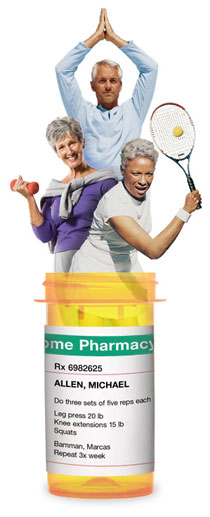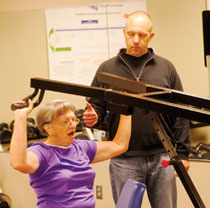New Center Dispenses Exercise as Medicine
By Jo Lynn Orr

The research is unequivocal: A healthy dose of regular exercise lowers a person’s risk for many diseases and boosts the chances of successful recovery. But should a young, female cancer patient be following the same regimen as a middle-aged man recovering from a heart attack? Current exercise guidelines are far too general—and lacking in careful research—to offer maximum benefit, says UAB exercise physiologist Marcas Bamman, Ph.D. For example, what is the best way to fight high blood pressure? Is it strength or endurance training, or some blend of the two? Bamman is addressing these questions as director of UAB’s new Center for Exercise Medicine (UCEM), which brings together dozens of physicians and scientists from across campus to study the most advantageous exercise treatments for heart disease, cancer, and many other diseases. “When it comes to strength training to prevent osteoporosis in older adults, particularly women, there haven’t been any specific dose-response studies done to know how much training would accomplish the ultimate goal of increasing bone density in the hip and spine,” Bamman says. “The same could be said for cardiometabolic disease risk factors.” UCEM researchers are now testing two different exercise doses to identify the one that best improves insulin sensitivity. These results will help to refine exercise prescription guidelines for patients with insulin resistance or type 2 diabetes. They also are developing a research-based strength-training program for older adults that can restore mobility, muscle mass, and metabolic function. “We’re doing this with a dose-response-treatment study with four different exercise prescriptions,” Bamman explains. “In the end, we’ll be able to say which of the four seems to do the best job.”  Marcas Bamman (right) is analyzing the best exercises for specific diseases. Marcas Bamman (right) is analyzing the best exercises for specific diseases.
Mario Laera, a Birmingham financial advisor in his sixties, has already benefitted from participation in UCEM’s research. Laera, who says he has always been an active person, injured his shoulder while lifting weights at home. “Through this program I was able to work in a structured setting and learn the proper way to do strength-conditioning exercises,” he says. “I didn’t know what I was doing wrong, but once I started the program, it didn’t take me long to figure out my mistakes.” Bamman hopes to add studies on Parkinson’s disease, joint repair and replacement, heart disease, and childhood obesity. “The goal is to determine how we can best intervene with exercise in specific diseases to have the greatest impact on quality of life,” he says.
|